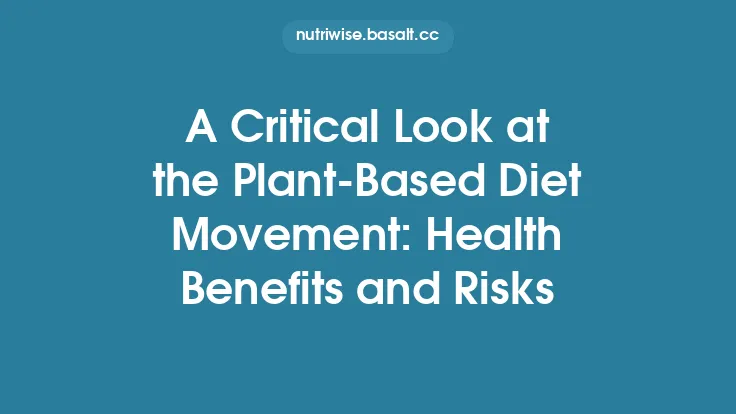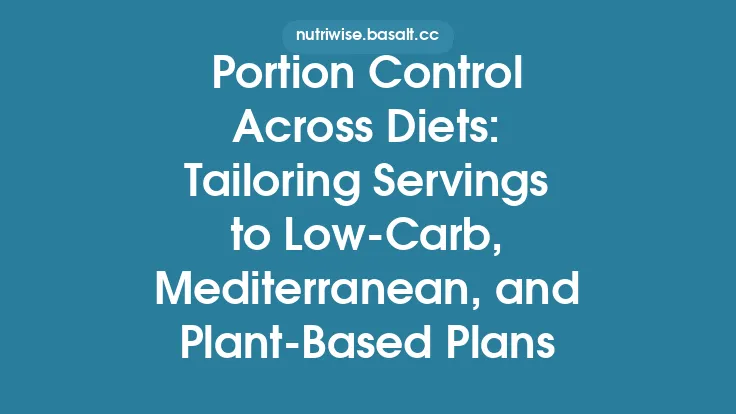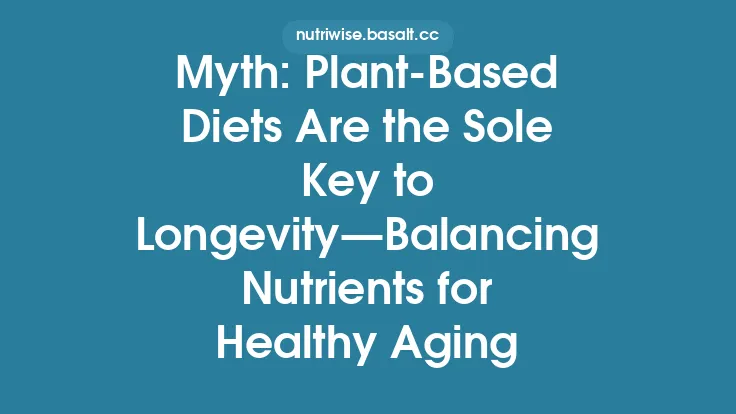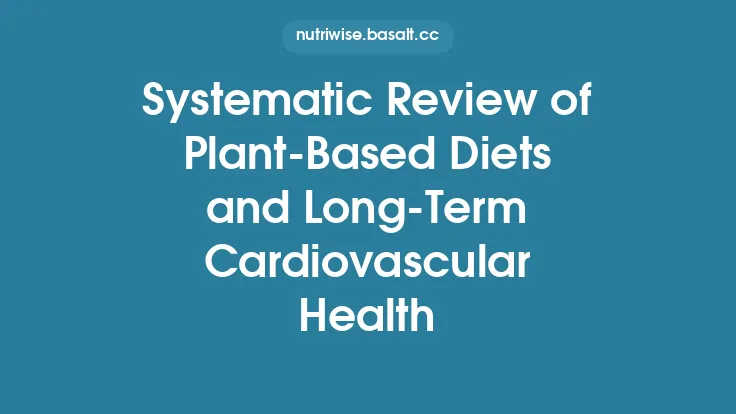Plant‑based eating has moved from a niche lifestyle choice to a mainstream dietary pattern embraced by millions worldwide. Its appeal lies not only in ethical and environmental considerations but also in a growing body of scientific evidence linking plant‑centric meals to a range of health benefits. This article provides an evergreen, in‑depth look at how plant‑based diets influence health and how to achieve a nutritionally balanced plate when animal products are minimized or eliminated.
Defining Plant‑Based Diets
A plant‑based diet is an umbrella term that encompasses several eating patterns that prioritize foods derived from plants—vegetables, fruits, legumes, whole grains, nuts, and seeds—while limiting or excluding animal‑derived products. The most common sub‑categories include:
| Pattern | Core Features | Typical Exclusions |
|---|---|---|
| Vegan | No animal products at all; relies entirely on plant foods. | Meat, dairy, eggs, honey, gelatin, and any animal‑derived additives. |
| Lacto‑ovo Vegetarian | Includes dairy and eggs but no meat, poultry, or fish. | All flesh foods and seafood. |
| Flexitarian (Plant‑Forward) | Primarily plant foods with occasional animal products. | Not a strict rule; animal foods are limited in frequency and portion size. |
| Whole‑Food Plant‑Based (WFPB) | Emphasizes minimally processed plant foods; excludes refined grains, added sugars, and oils. | Highly processed foods, refined sugars, and most added fats. |
While the degree of restriction varies, the common denominator is a high intake of fiber‑rich, nutrient‑dense plant foods and a reduced consumption of saturated fat and cholesterol.
Health Impacts: What the Evidence Shows
Cardiovascular Health
- Blood Lipids: Plant‑based diets consistently lower LDL‑cholesterol and total cholesterol. Soluble fiber (e.g., oats, barley, legumes) binds bile acids, prompting the liver to use circulating cholesterol to synthesize new bile, thereby reducing serum LDL levels.
- Blood Pressure: High potassium intake from fruits and vegetables, coupled with lower sodium consumption, contributes to modest reductions in systolic and diastolic blood pressure.
- Incidence of Heart Disease: Large prospective cohort studies (e.g., Adventist Health Study‑2) report a 20–30 % lower risk of coronary artery disease among long‑term vegetarians compared with omnivores.
Metabolic and Diabetes Outcomes
- Insulin Sensitivity: Diets rich in whole grains, legumes, and nuts improve insulin sensitivity through mechanisms such as reduced post‑prandial glucose spikes and enhanced muscle glucose uptake.
- Type 2 Diabetes Risk: Meta‑analyses indicate a 30 % lower incidence of type 2 diabetes in individuals adhering to vegetarian or vegan patterns, likely due to lower body mass index (BMI) and improved glycemic control.
Weight Management
- Energy Density: Plant foods generally have lower energy density (calories per gram) because of high water and fiber content, facilitating satiety with fewer calories.
- Body Composition: Controlled trials show modest but statistically significant reductions in body weight (average 3–5 kg) after 12–24 weeks of a plant‑based regimen, independent of intentional calorie restriction.
Cancer Prevention
- Phytonutrients: Compounds such as glucosinolates (cruciferous vegetables), flavonoids (berries, tea), and carotenoids (tomatoes, carrots) exhibit anti‑oxidative and anti‑inflammatory properties that may inhibit carcinogenesis.
- Epidemiology: Populations with high plant food consumption have lower rates of colorectal, breast, and prostate cancers, though confounding lifestyle factors must be considered.
Gut Microbiome
- Diversity: Dietary fiber serves as a prebiotic, fostering a diverse microbiota rich in short‑chain fatty acid (SCFA) producers (e.g., *Faecalibacterium prausnitzii*). SCFAs, especially butyrate, support colonic health and systemic metabolic regulation.
- Inflammation: A plant‑rich microbiome profile is associated with reduced systemic inflammatory markers (CRP, IL‑6).
Nutrient Balance: Meeting the Body’s Needs
Transitioning to a plant‑based diet can be nutritionally adequate, but careful planning is essential to avoid deficiencies in nutrients that are less abundant or less bioavailable in plant foods.
Protein
- Quantity: The Recommended Dietary Allowance (RDA) for protein is 0.8 g kg⁻¹ body weight for most adults. Plant proteins can meet this requirement when a variety of sources are consumed throughout the day.
- Quality: Complementary proteins (e.g., rice + beans, hummus + whole‑grain pita) provide a complete amino acid profile. Modern research shows that the “protein combining” at each meal is less critical than overall daily intake.
- Key Sources: Lentils (18 g/100 g), chickpeas (19 g/100 g), tofu (8 g/100 g), tempeh (19 g/100 g), quinoa (14 g/100 g), nuts and seeds (15–25 g/100 g).
Vitamin B12
- Risk: B12 is absent from plant foods; deficiency can lead to anemia and neurological issues.
- Solutions: Fortified plant milks, breakfast cereals, nutritional yeast, or a reliable B12 supplement (cyanocobalamin or methylcobalamin) providing 2–3 µg/day for adults.
Iron
- Forms: Plant iron is non‑heme, which has lower absorption (≈2–20 %) compared with heme iron from animal sources.
- Enhancers: Vitamin C (citrus, bell peppers) dramatically improves non‑heme iron absorption. Pairing iron‑rich foods (lentils, spinach, pumpkin seeds) with vitamin C sources is advisable.
- Inhibitors: Phytates (in whole grains, legumes) and polyphenols (in tea, coffee) can impede absorption; soaking, sprouting, and fermenting reduce phytate content.
Calcium
- Sources: Fortified plant milks, calcium‑set tofu, leafy greens (kale, bok choy), almonds, and tahini.
- Bioavailability: Oxalate‑rich greens (spinach, Swiss chard) have low calcium bioavailability; prioritize low‑oxalate options for calcium intake.
Omega‑3 Fatty Acids
- ALA: Alpha‑linolenic acid (ALA) is present in flaxseeds (2.4 g/100 g), chia seeds (1.6 g/100 g), hemp seeds, and walnuts.
- Conversion: The body converts ALA to EPA/DHA at low rates (≈5–10 % for EPA, <5 % for DHA). For those concerned about long‑chain omega‑3 status, algae‑derived EPA/DHA supplements are a plant‑based alternative.
Zinc
- Sources: Legumes, nuts, seeds, whole grains.
- Absorption: Phytates can inhibit zinc absorption; strategies such as soaking, sprouting, and fermenting improve bioavailability.
Iodine
- Sources: Iodized salt, seaweed (nori, kelp). Seaweed can provide excessive iodine if consumed in large amounts, so moderation is key.
Vitamin D
- Sources: Sunlight exposure, fortified plant milks, fortified orange juice, and vitamin D2/D3 supplements (the latter derived from lichen for vegan options).
Practical Strategies for a Balanced Plant‑Based Plate
- Adopt the “Plate Method”
- Half the plate: Non‑starchy vegetables (broccoli, leafy greens, peppers).
- Quarter: Whole grains or starchy vegetables (brown rice, quinoa, sweet potatoes).
- Quarter: Protein‑rich plant foods (legumes, tofu, tempeh, nuts).
- Diversify Protein Sources
Rotate legumes, soy products, nuts, seeds, and whole grains to ensure a broad amino acid intake and to keep meals interesting.
- Incorporate Fermented Foods
Tempeh, miso, kimchi, and sauerkraut not only add flavor but also improve nutrient bioavailability and support gut health.
- Mindful Meal Prep
- Soak beans and grains for 6–12 hours to reduce phytates.
- Sprout seeds and legumes to boost vitamin C and enzyme activity.
- Use a pressure cooker for beans to preserve nutrients while reducing cooking time.
- Plan for Micronutrient Gaps
Keep a simple spreadsheet or app to track intake of B12, iron, calcium, and omega‑3s, especially during the first few months of transition.
- Seasonal and Local Produce
Eating seasonally reduces cost and maximizes nutrient density, as fresh produce retains more vitamins and phytochemicals.
- Supplement Wisely
- B12: 2–3 µg/day (or 1000 µg weekly).
- Vitamin D: 800–2000 IU/day, depending on sun exposure and serum levels.
- EPA/DHA (algae): 250–500 mg/day for those not consuming fish.
Common Myths Debunked
| Myth | Reality |
|---|---|
| “Plant proteins are incomplete.” | Most plant foods contain all essential amino acids; the body pools amino acids over the day, making strict complementarity unnecessary. |
| “Vegans can’t build muscle.” | Resistance training combined with adequate total protein (1.2–1.7 g kg⁻¹) supports hypertrophy; many elite athletes thrive on plant‑based regimens. |
| “Plant‑based diets are automatically low in calories.” | Processed vegan foods (e.g., refined grain breads, sugary snacks) can be calorie‑dense; focus on whole foods for true energy balance. |
| “You’ll miss out on calcium.” | Calcium‑rich plant foods and fortified products can meet or exceed the RDA (1000 mg/day for most adults). |
| “All plant‑based diets are the same.” | Nutrient profiles vary widely; a diet heavy in refined carbs and low in legumes differs substantially from a whole‑food plant‑based approach. |
Sustainability and Long‑Term Viability
Beyond personal health, plant‑based eating aligns with environmental stewardship. Producing plant foods generally requires less land, water, and greenhouse‑gas emissions compared with animal agriculture. When individuals adopt a diet that is both nutritionally sound and environmentally responsible, the benefits compound across personal and planetary health.
Summary Checklist for a Nutritionally Sound Plant‑Based Lifestyle
- Variety: Include at least three different protein sources weekly.
- Fiber: Aim for ≥25 g/day (women) or ≥38 g/day (men) from whole plant foods.
- Micronutrients: Track B12, iron, calcium, omega‑3, zinc, iodine, and vitamin D.
- Whole Foods: Prioritize minimally processed grains, legumes, nuts, seeds, fruits, and vegetables.
- Fortification & Supplementation: Use fortified products and targeted supplements as needed.
- Preparation Techniques: Soak, sprout, ferment, and pressure‑cook to enhance nutrient absorption.
- Regular Monitoring: Periodic blood work (especially B12, ferritin, vitamin D) helps catch any emerging deficiencies early.
By adhering to these principles, a plant‑based diet can be a lifelong, health‑promoting, and nutritionally complete way of eating—truly an evergreen approach to nutrition.





